"Responsible AI", by Charlie Muirhead
1 like992 views
From The Hive's 2018 Annual Summit.
1 of 50
Downloaded 12 times




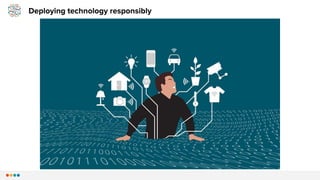
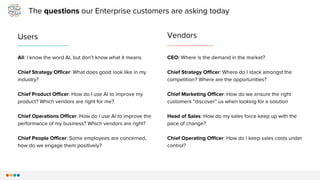
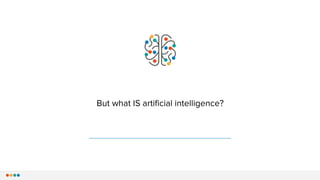

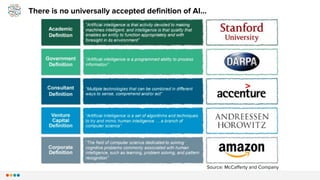

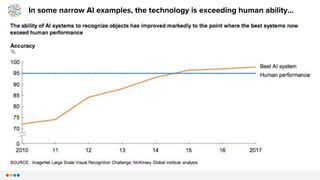
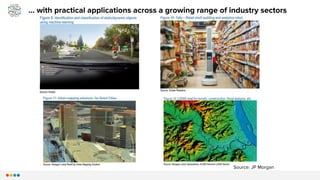
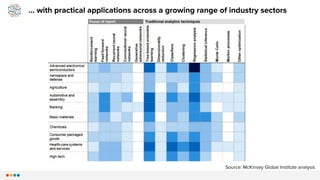
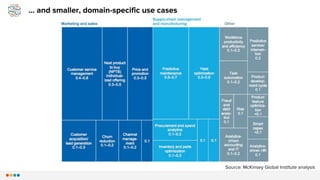
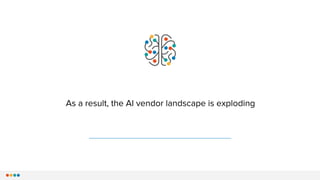
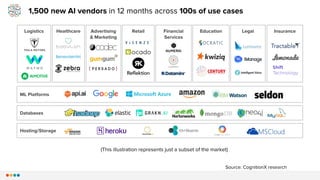

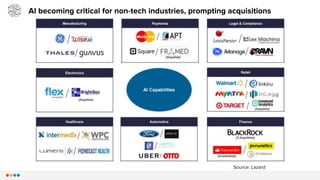




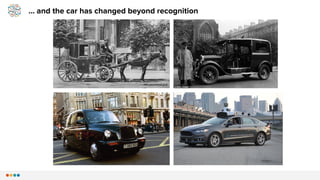
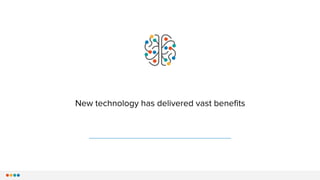





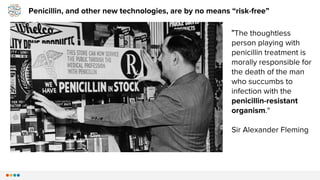

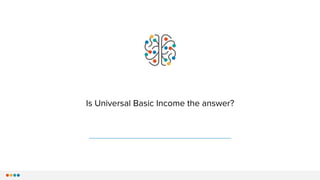

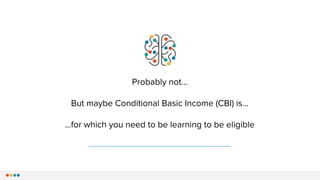
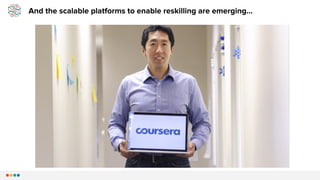
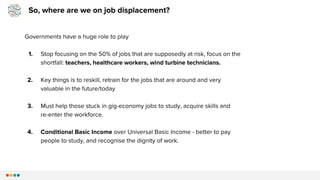
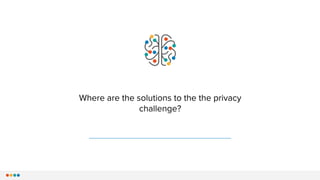



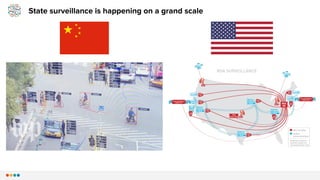
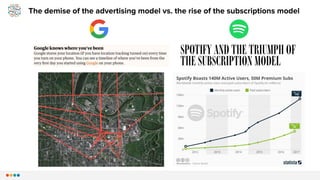

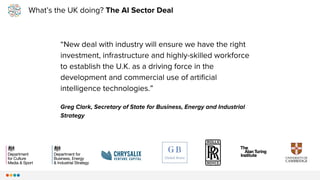
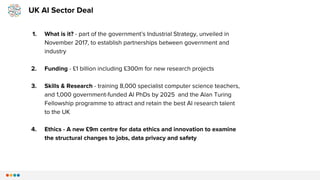

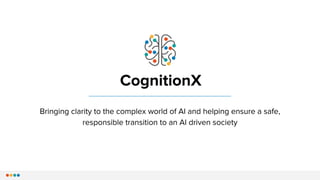
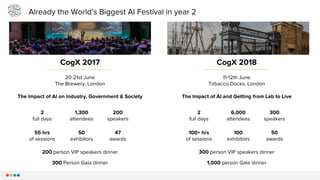
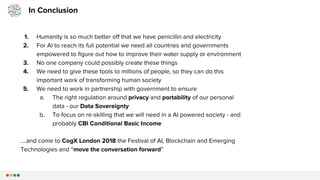
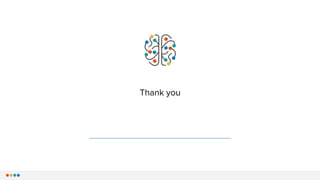
Ad
Recommended
Ten Tricks to Get the Creative Juices Flowing
Ten Tricks to Get the Creative Juices FlowingAbhishek Shah
╠²
Amateurs wait for inspiration to strike. The pros know how to cultivate creativity on an ongoing basis. Here are Ten Tricks to Get the Creative Juices Flowing. 10 english phrases to avoid answering a question
10 english phrases to avoid answering a questionLakkamraju Raviteja
╠²
phrases used in day to day lifeTranslating a Trillion Points of Data into Therapies, Diagnostics, and New In...
Translating a Trillion Points of Data into Therapies, Diagnostics, and New In...The Hive
╠²
This document outlines Atul Butte's extensive conflicts of interest and corporate relationships in the biomedical data and technology industry. It then provides brief summaries of several companies started by Butte's students using public data to develop diagnostics, predict disease, and design new drugs. The document concludes by listing Butte's collaborators and supporters in establishing a large biomedical data institute at UCSF.Digital Transformation; Digital Twins for Delivering Business Value in IIoT
Digital Transformation; Digital Twins for Delivering Business Value in IIoTThe Hive
╠²
The document from Rockwell Automation highlights the significance of digital transformation and the role of digital twins in enhancing business value within industrial automation. It emphasizes trends such as secure computing, big data analytics, and predictive maintenance as crucial for improving asset utilization and operational efficiency. By 2021, it's projected that many large industrial companies will leverage digital twins, leading to improved effectiveness and integration across various processes.Quantum Computing (IBM Q) - Hive Think Tank Event w/ Dr. Bob Sutor - 02.22.18
Quantum Computing (IBM Q) - Hive Think Tank Event w/ Dr. Bob Sutor - 02.22.18The Hive
╠²
The document introduces quantum computing and IBM's efforts in the field, including the IBM Q Experience launched in 2016 which allows users to run algorithms and experiments on quantum computers via the cloud. It discusses IBM's goals of building universal fault-tolerant quantum computers and the IBM Q Network, a global community to advance quantum computing.The Hive Think Tank: Rendezvous Architecture Makes Machine Learning Logistics...
The Hive Think Tank: Rendezvous Architecture Makes Machine Learning Logistics...The Hive
╠²
The document discusses the complexities of machine learning model management, emphasizing that a significant portion of effort goes into logistics and data handling rather than just model training. It highlights the need for a platform that supports logistics effectively, advocates for a stream-first architecture, and outlines key practices such as using canary models and ensemble modeling to improve performance and management of machine learning models. Additional resources and insights into data operations, model coupling, and maintaining operational readiness are also provided.Data Science in the Enterprise
Data Science in the EnterpriseThe Hive
╠²
The document discusses the workflow and challenges faced in enterprise data science, emphasizing the roles of data scientists and engineers, along with common limitations related to data access and tool compatibility. It introduces Cloudera Data Science Workbench as a solution to accelerate data science from development to production, providing secure environments and support for multiple programming languages. Key benefits include support for fully secured clusters and a multi-tenant architecture that facilitates collaboration and resource management.AI in Software for Augmenting Intelligence Across the Enterprise
AI in Software for Augmenting Intelligence Across the EnterpriseThe Hive
╠²
The document outlines strategies for leveraging AI and analytics to enhance intelligence and operational efficiency in enterprise software, particularly within the context of TIBCO and Western Digital. It emphasizes the importance of data-driven decision-making, smart manufacturing, and the integration of machine learning across various platforms to optimize business processes. Additionally, it discusses the evolution of storage technologies and the role of advanced analytics in managing complex manufacturing operations.ŌĆ£ High Precision Analytics for Healthcare: Promises and ChallengesŌĆØ by Sriram...
ŌĆ£ High Precision Analytics for Healthcare: Promises and ChallengesŌĆØ by Sriram...The Hive
╠²
1) Predictive analytics in healthcare often provides risk scores and predictions but lacks actionable insights on how to prevent outcomes.
2) The right methodology is needed to transform raw data like claims, prescriptions and medical records into meaningful predictions using machine learning algorithms.
3) Accurate predictions require measuring precision down to the individual level while accounting for both patient and provider factors that influence health outcomes."The Future of Manufacturing" by Sujeet Chand, SVP&CTO, Rockwell Automation
"The Future of Manufacturing" by Sujeet Chand, SVP&CTO, Rockwell AutomationThe Hive
╠²
The document discusses the future of manufacturing through the lens of the Connected Enterprise, emphasizing the importance of technology, such as IoT and analytics, to optimize operations and enhance competitiveness. It highlights challenges like talent shortages and the need for collaboration within industry consortia to adapt to changing landscapes. Ultimately, the goal is to create a self-optimizing, secure manufacturing environment capable of predicting and addressing issues proactively.Social Impact & Ethics of AI by Steve Omohundro
Social Impact & Ethics of AI by Steve OmohundroThe Hive
╠²
The document discusses the social impacts and ethical considerations of artificial intelligence, highlighting effects on the economy, employment, governance, and warfare. It also emphasizes the potential for technological advancements to either create utopian or dystopian futures, stressing the necessity of governance and innovative approaches in AI development. Lastly, it calls for awareness of risks, such as inequality and social disconnection, that may arise alongside technological progress.The Hive Think Tank: AI in The Enterprise by Venkat Srinivasan
The Hive Think Tank: AI in The Enterprise by Venkat SrinivasanThe Hive
╠²
The document discusses the integration of artificial intelligence (AI) and machine intelligence in enterprises, emphasizing the need for natural language understanding and data analysis methods amidst the era of big data. It outlines various applications and solutions for data extraction, classification, and real-time intelligence, highlighting the importance of accuracy, traceability, and handling variability in AI systems. The overall impact points toward transforming business architecture through intelligent machines and changing human roles in enterprise operations.The Hive Think Tank: Machine Learning Applications in Genomics by Prof. Jian ...
The Hive Think Tank: Machine Learning Applications in Genomics by Prof. Jian ...The Hive
╠²
The document discusses new algorithms in computational genomics aimed at understanding cancer genomes and their implications in personalized precision medicine. It highlights the significance of data management, analysis, and security in cancer research, emphasizing the need to extract meaningful patterns from genomic sequences. Additionally, it addresses the role of non-coding regions in the genome and their impact on human biology and diseases.The Hive Think Tank: The Future Of Customer Support - AI Driven Automation
The Hive Think Tank: The Future Of Customer Support - AI Driven AutomationThe Hive
╠²
The document discusses the future of customer support and highlights the role of AI-driven automation in enhancing customer service experiences. It emphasizes the importance of valuing customers' time and the rise of cognitive computing and robotic process automation in this context. Additionally, it underscores that effective service delivery relies on intelligent systems that improve both self-service and agent assistance.The Hive Think Tank: Talk by Mohandas Pai - India at 2030, How Tech Entrepren...
The Hive Think Tank: Talk by Mohandas Pai - India at 2030, How Tech Entrepren...The Hive
╠²
This document discusses how India can become a $10 trillion economy by 2030 through technology entrepreneurship and the growth of its startup ecosystem. It notes that India currently has the 3rd largest startup ecosystem in the world with 19,400 startups. If the ecosystem continues growing at 270% over 6 years, it could create $500 billion in market value and employ over 3.5 million people by 2030. This growth will be accelerated by initiatives like Digital India that are building digital infrastructure and opening government data through APIs, fueling innovation and problem solving across sectors to help propel India to its economic goals.The Hive Think Tank: The Content Trap - Strategist's Guide to Digital Change
The Hive Think Tank: The Content Trap - Strategist's Guide to Digital ChangeThe Hive
╠²
The document discusses the strategic implications of digital transformation, using examples from various industries, including newspapers and music, to illustrate the challenges presented by online competition and changing consumer behaviors. It emphasizes the importance of understanding user connections, complements, and product connections as key factors for success in a digital landscape. The insights suggest that traditional approaches focused on product quality and benchmarking are insufficient for navigating these disruptions.Deep Visual Understanding from Deep Learning by Prof. Jitendra Malik
Deep Visual Understanding from Deep Learning by Prof. Jitendra MalikThe Hive
╠²
The document discusses the evolution of visual understanding through deep learning, highlighting key advancements in object detection and AI milestones influenced by human cognitive development and the structure of the human brain. It details historical progress in computer vision from the 1960s to the 2010s, including the emergence of convolutional neural networks and significant breakthroughs such as R-CNN and Fast R-CNN. Additionally, the document touches on the challenges in achieving human-level AI, the importance of multimodal learning, and the role of experiential learning in developing predictive models of physical interactions.The Hive Think Tank: Heron at Twitter
The Hive Think Tank: Heron at TwitterThe Hive
╠²
This document provides an overview and hands-on demonstration of Twitter's Heron stream processing framework. The agenda includes a Heron overview, hands-on experience launching topologies and using Heron tools, and exploring the UI. Instructions are given on installing Heron client and tools binaries. Example topologies are launched using the 'heron submit' command. The Heron tracker and UI are launched to view logical/physical plans, metrics, logs, and exceptions. Additional resources mentioned include the Heron starters repository and user forum.The Hive Think Tank: Unpacking AI for Healthcare
The Hive Think Tank: Unpacking AI for Healthcare The Hive
╠²
The document discusses the complexities and challenges in the healthcare sector, particularly around data management and care coordination, which hinder timely and effective patient care. It highlights the promise of AI in automating risk and care management processes to improve efficiency, reduce costs, and deliver personalized healthcare solutions. Lumiata is presented as a pioneering solution, leveraging medical AI to improve healthcare outcomes through precise predictions and seamless integration with clinical workflows.The Hive Think Tank: Translating IoT into Innovation at Every Level by Prith ...
The Hive Think Tank: Translating IoT into Innovation at Every Level by Prith ...The Hive
╠²
The document discusses the transformative impact of IoT on energy management and operational efficiency across various sectors, emphasizing the integration of IT and OT. It describes solutions like EcoStruxure for enhanced control, analytics, and predictive modeling to improve performance and sustainability. The document highlights the capability to connect and monitor assets, enabling data-driven decisions and strategies for energy optimization and savings.The Hive Think Tank - The Microsoft Big Data Stack by Raghu Ramakrishnan, CTO...
The Hive Think Tank - The Microsoft Big Data Stack by Raghu Ramakrishnan, CTO...The Hive
╠²
The document outlines Microsoft's data and analytics strategy, emphasizing their integrated solutions like SQL Server, Azure SQL Database, and Cortana Intelligence Suite which enable advanced analytics and real-time data processing. It highlights the scalability and flexibility of their tools for managing massive data volumes across cloud and on-premises environments, while providing functionalities such as machine learning and predictive analytics. Additionally, the document includes references to Gartner's research and emphasizes the importance of a seamless user experience from enterprise to cloud environments.The Hive Think Tank - Design Thinking by Bernie Roth, Professor at Stanford U...
The Hive Think Tank - Design Thinking by Bernie Roth, Professor at Stanford U...The Hive
╠²
The document discusses the principles of design thinking, emphasizing the importance of empathy, experimentation, and collaboration in the innovation process. It outlines the design thinking process, including understanding user needs, framing problems, and committing to satisfying those needs. Key mindsets highlighted include a bias toward action and the courage to embrace failure for effective problem-solving.Agentic AI for Developers and Data Scientists Build an AI Agent in 10 Lines o...
Agentic AI for Developers and Data Scientists Build an AI Agent in 10 Lines o...All Things Open
╠²
Presented at All Things Open RTP Meetup
Presented by William Hill - Developer Advocate, NVIDIA
Title: Agentic AI for Developers and Data Scientists
Build an AI Agent in 10 Lines of Code and the Concepts Behind the Code
Abstract: In this talk we will demonstrate building a working data science AI agent in 10 lines of basic Python code in a Colab notebook. Our AI Agent will perform LLM prompt-driven visual analysis using open-source libraries. In this session we will show how to develop an AI Agent using GPUs through NVIDIAŌĆÖs developer program and Google Colab notebooks. After coding our AI Agent, we will break down the 10 lines of code. We will show the key components and open source library integrations that enable the agent's functionality, focusing on practical implementation details and then the theoretical concepts. The presentation concludes with a survey of current LLM technologies and the latest trends in developing AI applications for enthusiasts and enterprisesSecurity Tips for Enterprise Azure Solutions
Security Tips for Enterprise Azure SolutionsMichele Leroux Bustamante
╠²
Delivering solutions to Azure may involve a variety of architecture patterns involving your applications, APIs data and associated Azure resources that comprise the solution. This session will use reference architectures to illustrate the security considerations to protect your Azure resources and data, how to achieve Zero Trust, and why it matters. Topics covered will include specific security recommendations for types Azure resources and related network security practices. The goal is to give you a breadth of understanding as to typical security requirements to meet compliance and security controls in an enterprise solution.More Related Content
More from The Hive (20)
Translating a Trillion Points of Data into Therapies, Diagnostics, and New In...
Translating a Trillion Points of Data into Therapies, Diagnostics, and New In...The Hive
╠²
This document outlines Atul Butte's extensive conflicts of interest and corporate relationships in the biomedical data and technology industry. It then provides brief summaries of several companies started by Butte's students using public data to develop diagnostics, predict disease, and design new drugs. The document concludes by listing Butte's collaborators and supporters in establishing a large biomedical data institute at UCSF.Digital Transformation; Digital Twins for Delivering Business Value in IIoT
Digital Transformation; Digital Twins for Delivering Business Value in IIoTThe Hive
╠²
The document from Rockwell Automation highlights the significance of digital transformation and the role of digital twins in enhancing business value within industrial automation. It emphasizes trends such as secure computing, big data analytics, and predictive maintenance as crucial for improving asset utilization and operational efficiency. By 2021, it's projected that many large industrial companies will leverage digital twins, leading to improved effectiveness and integration across various processes.Quantum Computing (IBM Q) - Hive Think Tank Event w/ Dr. Bob Sutor - 02.22.18
Quantum Computing (IBM Q) - Hive Think Tank Event w/ Dr. Bob Sutor - 02.22.18The Hive
╠²
The document introduces quantum computing and IBM's efforts in the field, including the IBM Q Experience launched in 2016 which allows users to run algorithms and experiments on quantum computers via the cloud. It discusses IBM's goals of building universal fault-tolerant quantum computers and the IBM Q Network, a global community to advance quantum computing.The Hive Think Tank: Rendezvous Architecture Makes Machine Learning Logistics...
The Hive Think Tank: Rendezvous Architecture Makes Machine Learning Logistics...The Hive
╠²
The document discusses the complexities of machine learning model management, emphasizing that a significant portion of effort goes into logistics and data handling rather than just model training. It highlights the need for a platform that supports logistics effectively, advocates for a stream-first architecture, and outlines key practices such as using canary models and ensemble modeling to improve performance and management of machine learning models. Additional resources and insights into data operations, model coupling, and maintaining operational readiness are also provided.Data Science in the Enterprise
Data Science in the EnterpriseThe Hive
╠²
The document discusses the workflow and challenges faced in enterprise data science, emphasizing the roles of data scientists and engineers, along with common limitations related to data access and tool compatibility. It introduces Cloudera Data Science Workbench as a solution to accelerate data science from development to production, providing secure environments and support for multiple programming languages. Key benefits include support for fully secured clusters and a multi-tenant architecture that facilitates collaboration and resource management.AI in Software for Augmenting Intelligence Across the Enterprise
AI in Software for Augmenting Intelligence Across the EnterpriseThe Hive
╠²
The document outlines strategies for leveraging AI and analytics to enhance intelligence and operational efficiency in enterprise software, particularly within the context of TIBCO and Western Digital. It emphasizes the importance of data-driven decision-making, smart manufacturing, and the integration of machine learning across various platforms to optimize business processes. Additionally, it discusses the evolution of storage technologies and the role of advanced analytics in managing complex manufacturing operations.ŌĆ£ High Precision Analytics for Healthcare: Promises and ChallengesŌĆØ by Sriram...
ŌĆ£ High Precision Analytics for Healthcare: Promises and ChallengesŌĆØ by Sriram...The Hive
╠²
1) Predictive analytics in healthcare often provides risk scores and predictions but lacks actionable insights on how to prevent outcomes.
2) The right methodology is needed to transform raw data like claims, prescriptions and medical records into meaningful predictions using machine learning algorithms.
3) Accurate predictions require measuring precision down to the individual level while accounting for both patient and provider factors that influence health outcomes."The Future of Manufacturing" by Sujeet Chand, SVP&CTO, Rockwell Automation
"The Future of Manufacturing" by Sujeet Chand, SVP&CTO, Rockwell AutomationThe Hive
╠²
The document discusses the future of manufacturing through the lens of the Connected Enterprise, emphasizing the importance of technology, such as IoT and analytics, to optimize operations and enhance competitiveness. It highlights challenges like talent shortages and the need for collaboration within industry consortia to adapt to changing landscapes. Ultimately, the goal is to create a self-optimizing, secure manufacturing environment capable of predicting and addressing issues proactively.Social Impact & Ethics of AI by Steve Omohundro
Social Impact & Ethics of AI by Steve OmohundroThe Hive
╠²
The document discusses the social impacts and ethical considerations of artificial intelligence, highlighting effects on the economy, employment, governance, and warfare. It also emphasizes the potential for technological advancements to either create utopian or dystopian futures, stressing the necessity of governance and innovative approaches in AI development. Lastly, it calls for awareness of risks, such as inequality and social disconnection, that may arise alongside technological progress.The Hive Think Tank: AI in The Enterprise by Venkat Srinivasan
The Hive Think Tank: AI in The Enterprise by Venkat SrinivasanThe Hive
╠²
The document discusses the integration of artificial intelligence (AI) and machine intelligence in enterprises, emphasizing the need for natural language understanding and data analysis methods amidst the era of big data. It outlines various applications and solutions for data extraction, classification, and real-time intelligence, highlighting the importance of accuracy, traceability, and handling variability in AI systems. The overall impact points toward transforming business architecture through intelligent machines and changing human roles in enterprise operations.The Hive Think Tank: Machine Learning Applications in Genomics by Prof. Jian ...
The Hive Think Tank: Machine Learning Applications in Genomics by Prof. Jian ...The Hive
╠²
The document discusses new algorithms in computational genomics aimed at understanding cancer genomes and their implications in personalized precision medicine. It highlights the significance of data management, analysis, and security in cancer research, emphasizing the need to extract meaningful patterns from genomic sequences. Additionally, it addresses the role of non-coding regions in the genome and their impact on human biology and diseases.The Hive Think Tank: The Future Of Customer Support - AI Driven Automation
The Hive Think Tank: The Future Of Customer Support - AI Driven AutomationThe Hive
╠²
The document discusses the future of customer support and highlights the role of AI-driven automation in enhancing customer service experiences. It emphasizes the importance of valuing customers' time and the rise of cognitive computing and robotic process automation in this context. Additionally, it underscores that effective service delivery relies on intelligent systems that improve both self-service and agent assistance.The Hive Think Tank: Talk by Mohandas Pai - India at 2030, How Tech Entrepren...
The Hive Think Tank: Talk by Mohandas Pai - India at 2030, How Tech Entrepren...The Hive
╠²
This document discusses how India can become a $10 trillion economy by 2030 through technology entrepreneurship and the growth of its startup ecosystem. It notes that India currently has the 3rd largest startup ecosystem in the world with 19,400 startups. If the ecosystem continues growing at 270% over 6 years, it could create $500 billion in market value and employ over 3.5 million people by 2030. This growth will be accelerated by initiatives like Digital India that are building digital infrastructure and opening government data through APIs, fueling innovation and problem solving across sectors to help propel India to its economic goals.The Hive Think Tank: The Content Trap - Strategist's Guide to Digital Change
The Hive Think Tank: The Content Trap - Strategist's Guide to Digital ChangeThe Hive
╠²
The document discusses the strategic implications of digital transformation, using examples from various industries, including newspapers and music, to illustrate the challenges presented by online competition and changing consumer behaviors. It emphasizes the importance of understanding user connections, complements, and product connections as key factors for success in a digital landscape. The insights suggest that traditional approaches focused on product quality and benchmarking are insufficient for navigating these disruptions.Deep Visual Understanding from Deep Learning by Prof. Jitendra Malik
Deep Visual Understanding from Deep Learning by Prof. Jitendra MalikThe Hive
╠²
The document discusses the evolution of visual understanding through deep learning, highlighting key advancements in object detection and AI milestones influenced by human cognitive development and the structure of the human brain. It details historical progress in computer vision from the 1960s to the 2010s, including the emergence of convolutional neural networks and significant breakthroughs such as R-CNN and Fast R-CNN. Additionally, the document touches on the challenges in achieving human-level AI, the importance of multimodal learning, and the role of experiential learning in developing predictive models of physical interactions.The Hive Think Tank: Heron at Twitter
The Hive Think Tank: Heron at TwitterThe Hive
╠²
This document provides an overview and hands-on demonstration of Twitter's Heron stream processing framework. The agenda includes a Heron overview, hands-on experience launching topologies and using Heron tools, and exploring the UI. Instructions are given on installing Heron client and tools binaries. Example topologies are launched using the 'heron submit' command. The Heron tracker and UI are launched to view logical/physical plans, metrics, logs, and exceptions. Additional resources mentioned include the Heron starters repository and user forum.The Hive Think Tank: Unpacking AI for Healthcare
The Hive Think Tank: Unpacking AI for Healthcare The Hive
╠²
The document discusses the complexities and challenges in the healthcare sector, particularly around data management and care coordination, which hinder timely and effective patient care. It highlights the promise of AI in automating risk and care management processes to improve efficiency, reduce costs, and deliver personalized healthcare solutions. Lumiata is presented as a pioneering solution, leveraging medical AI to improve healthcare outcomes through precise predictions and seamless integration with clinical workflows.The Hive Think Tank: Translating IoT into Innovation at Every Level by Prith ...
The Hive Think Tank: Translating IoT into Innovation at Every Level by Prith ...The Hive
╠²
The document discusses the transformative impact of IoT on energy management and operational efficiency across various sectors, emphasizing the integration of IT and OT. It describes solutions like EcoStruxure for enhanced control, analytics, and predictive modeling to improve performance and sustainability. The document highlights the capability to connect and monitor assets, enabling data-driven decisions and strategies for energy optimization and savings.The Hive Think Tank - The Microsoft Big Data Stack by Raghu Ramakrishnan, CTO...
The Hive Think Tank - The Microsoft Big Data Stack by Raghu Ramakrishnan, CTO...The Hive
╠²
The document outlines Microsoft's data and analytics strategy, emphasizing their integrated solutions like SQL Server, Azure SQL Database, and Cortana Intelligence Suite which enable advanced analytics and real-time data processing. It highlights the scalability and flexibility of their tools for managing massive data volumes across cloud and on-premises environments, while providing functionalities such as machine learning and predictive analytics. Additionally, the document includes references to Gartner's research and emphasizes the importance of a seamless user experience from enterprise to cloud environments.The Hive Think Tank - Design Thinking by Bernie Roth, Professor at Stanford U...
The Hive Think Tank - Design Thinking by Bernie Roth, Professor at Stanford U...The Hive
╠²
The document discusses the principles of design thinking, emphasizing the importance of empathy, experimentation, and collaboration in the innovation process. It outlines the design thinking process, including understanding user needs, framing problems, and committing to satisfying those needs. Key mindsets highlighted include a bias toward action and the courage to embrace failure for effective problem-solving.Recently uploaded (20)
Agentic AI for Developers and Data Scientists Build an AI Agent in 10 Lines o...
Agentic AI for Developers and Data Scientists Build an AI Agent in 10 Lines o...All Things Open
╠²
Presented at All Things Open RTP Meetup
Presented by William Hill - Developer Advocate, NVIDIA
Title: Agentic AI for Developers and Data Scientists
Build an AI Agent in 10 Lines of Code and the Concepts Behind the Code
Abstract: In this talk we will demonstrate building a working data science AI agent in 10 lines of basic Python code in a Colab notebook. Our AI Agent will perform LLM prompt-driven visual analysis using open-source libraries. In this session we will show how to develop an AI Agent using GPUs through NVIDIAŌĆÖs developer program and Google Colab notebooks. After coding our AI Agent, we will break down the 10 lines of code. We will show the key components and open source library integrations that enable the agent's functionality, focusing on practical implementation details and then the theoretical concepts. The presentation concludes with a survey of current LLM technologies and the latest trends in developing AI applications for enthusiasts and enterprisesSecurity Tips for Enterprise Azure Solutions
Security Tips for Enterprise Azure SolutionsMichele Leroux Bustamante
╠²
Delivering solutions to Azure may involve a variety of architecture patterns involving your applications, APIs data and associated Azure resources that comprise the solution. This session will use reference architectures to illustrate the security considerations to protect your Azure resources and data, how to achieve Zero Trust, and why it matters. Topics covered will include specific security recommendations for types Azure resources and related network security practices. The goal is to give you a breadth of understanding as to typical security requirements to meet compliance and security controls in an enterprise solution.Tech-ASan: Two-stage check for Address Sanitizer - Yixuan Cao.pdf
Tech-ASan: Two-stage check for Address Sanitizer - Yixuan Cao.pdfcaoyixuan2019
╠²
A presentation at Internetware 2025.Database Benchmarking for Performance Masterclass: Session 2 - Data Modeling ...
Database Benchmarking for Performance Masterclass: Session 2 - Data Modeling ...ScyllaDB
╠²
Specific best practices and pitfalls for benchmarking popular high-performance databases."Database isolation: how we deal with hundreds of direct connections to the d...
"Database isolation: how we deal with hundreds of direct connections to the d...Fwdays
╠²
What can go wrong if you allow each service to access the database directly? In a startup, this seems like a quick and easy solution, but as the system scales, problems appear that no one could have guessed.
In my talk, I'll share Solidgate's experience in transforming its architecture: from the chaos of direct connections to a service-based data access model. I will talk about the transition stages, bottlenecks, and how isolation affected infrastructure support. I will honestly show what worked and what didn't. In short, we will analyze the controversy of this talk.Raman Bhaumik - Passionate Tech Enthusiast
Raman Bhaumik - Passionate Tech EnthusiastRaman Bhaumik
╠²
A Junior Software Developer with a flair for innovation, Raman Bhaumik excels in delivering scalable web solutions. With three years of experience and a solid foundation in Java, Python, JavaScript, and SQL, she has streamlined task tracking by 20% and improved application stability.Lessons Learned from Developing Secure AI Workflows.pdf
Lessons Learned from Developing Secure AI Workflows.pdfPriyanka Aash
╠²
Lessons Learned from Developing Secure AI WorkflowsThe Future of Product Management in AI ERA.pdf
The Future of Product Management in AI ERA.pdfAlyona Owens
╠²
Hi, IŌĆÖm Aly Owens, I have a special pleasure to stand here as over a decade ago I graduated from CityU as an international student with an MBA program. I enjoyed the diversity of the school, ability to work and study, the network that came with being here, and of course the price tag for students here has always been more affordable than most around.
Since then I have worked for major corporations like T-Mobile and Microsoft and many more, and I have founded a startup. I've also been teaching product management to ensure my students save time and money to get to the same level as me faster avoiding popular mistakes. Today as IŌĆÖve transitioned to teaching and focusing on the startup, I hear everybody being concerned about Ai stealing their jobsŌĆ” WeŌĆÖll talk about it shortly.
But before that, I want to take you back to 1997. One of my favorite movies is ŌĆ£Fifth ElementŌĆØ. It wowed me with futuristic predictions when I was a kid and IŌĆÖm impressed by the number of these predictions that have already come true. Self-driving cars, video calls and smart TV, personalized ads and identity scanning. Sci-fi movies and books gave us many ideas and some are being implemented as we speak. But we often get ahead of ourselves:
Flying cars,Colonized planets, Human-like AI: not yet, Time travel, Mind-machine neural interfaces for everyone: Only in experimental stages (e.g. Neuralink).
Cyberpunk dystopias: Some vibes (neon signs + inequality + surveillance), but not total dystopia (thankfully).
On the bright side, we predict that the working hours should drop as Ai becomes our helper and there shouldnŌĆÖt be a need to work 8 hours/day. Nobody knows for sure but we can require that from legislation. Instead of waiting to see what the government and billionaires come up with, I say we should design our own future.
So, we as humans, when we donŌĆÖt know something - fear takes over. The same thing happened during the industrial revolution. In the Industrial Era, machines didnŌĆÖt steal jobsŌĆöthey transformed them but people were scared about their jobs. The AI era is making similar changes except it feels like robots will take the center stage instead of a human. First off, even when it comes to the hottest space in the military - drones, Ai does a fraction of work. AI algorithms enable real-time decision-making, obstacle avoidance, and mission optimization making drones far more autonomous and capable than traditional remote-controlled aircraft. Key technologies include computer vision for object detection, GPS-enhanced navigation, and neural networks for learning and adaptation. But guess what? There are only 2 companies right now that utilize Ai in drones to make autonomous decisions - Skydio and DJI.
Mastering AI Workflows with FME by Mark Do╠łring
Mastering AI Workflows with FME by Mark Do╠łringSafe Software
╠²
Harness the full potential of AI with FME: From creating high-quality training data to optimizing models and utilizing results, FME supports every step of your AI workflow. Seamlessly integrate a wide range of models, including those for data enhancement, forecasting, image and object recognition, and large language models. Customize AI models to meet your exact needs with FMEŌĆÖs powerful tools for training, optimization, and seamless integrationGenAI Opportunities and Challenges - Where 370 Enterprises Are Focusing Now.pdf
GenAI Opportunities and Challenges - Where 370 Enterprises Are Focusing Now.pdfPriyanka Aash
╠²
GenAI Opportunities and Challenges - Where 370 Enterprises Are Focusing Now10 Key Challenges for AI within the EU Data Protection Framework.pdf
10 Key Challenges for AI within the EU Data Protection Framework.pdfPriyanka Aash
╠²
10 Key Challenges for AI within the EU Data Protection FrameworkOh, the Possibilities - Balancing Innovation and Risk with Generative AI.pdf
Oh, the Possibilities - Balancing Innovation and Risk with Generative AI.pdfPriyanka Aash
╠²
Oh, the Possibilities - Balancing Innovation and Risk with Generative AI" How to survive with 1 billion vectors and not sell a kidney: our low-cost c...
" How to survive with 1 billion vectors and not sell a kidney: our low-cost c...Fwdays
╠²
Let's talk about our history. How we started the project with a small vector database of less than 2 million records. Later, we received a request for +100 million records, then another +100... And so gradually we reached almost 1 billion. Standard tools were quickly running out of steam - we were running into performance, index size, and very limited resources. After a long series of trials and errors, we built our own low-cost cluster, which today stably processes thousands of queries to more than 1B vectors."Scaling in space and time with Temporal", Andriy Lupa.pdf
"Scaling in space and time with Temporal", Andriy Lupa.pdfFwdays
╠²
Design patterns like Event Sourcing and Event Streaming have long become standards for building real-time analytics systems. However, when the system load becomes nonlinear with fast and often unpredictable spikes, it's crucial to respond quickly in order not to lose real-time operating itself.
In this talk, IŌĆÖll share my experience implementing and using a tool like Temporal.io. We'll explore the evolution of our system for maintaining real-time report generation and discuss how we use Temporal both for short-lived pipelines and long-running background tasks.The Growing Value and Application of FME & GenAI
The Growing Value and Application of FME & GenAISafe Software
╠²
With the cost of using Generative AI services dropping exponentially and the array of available models continually expanding, integrating AI into FME workflows has become inexpensive, accessible and effective. This presentation explores how GenAI within FME can cost-effectively transform data workflows by automating data extraction, validation, classification and augmentation tasks. WeŌĆÖll discuss how FMEŌĆÖs no-code flexibility enables users to combine Generative AI and Computer Vision tools that create efficient workflows tailored to specific challenges. Using recent practical examples, weŌĆÖll demonstrate how these integrations can simplify complex tasks, save time and enhance data quality.Quantum AI Discoveries: Fractal Patterns Consciousness and Cyclical Universes
Quantum AI Discoveries: Fractal Patterns Consciousness and Cyclical UniversesSaikat Basu
╠²
Embark on a cosmic journey exploring the intersection of quantum
computing, consciousness, and ancient wisdom. Together we'll uncover the
recursive patterns that bind our reality.AI vs Human Writing: Can You Tell the Difference?
AI vs Human Writing: Can You Tell the Difference?Shashi Sathyanarayana, Ph.D
╠²
This slide illustrates a side-by-side comparison between human-written, AI-written, and ambiguous content. It highlights subtle cues that help readers assess authenticity, raising essential questions about the future of communication, trust, and thought leadership in the age of generative AI.Salesforce Summer '25 Release Frenchgathering.pptx.pdf
Salesforce Summer '25 Release Frenchgathering.pptx.pdfyosra Saidani
╠²
Salesforce Summer '25 Release Frenchgathering.pptx.pdfAd
"Responsible AI", by Charlie Muirhead
- 30. "
